The Ankole cattle are a special breed of African cattle which stand out because of their long white-curved outside horns and a dark-brown skin color. The long horns evolved to protect them from predators like hyenas, lions and leopards. They are often referred to as Cattle of the Kings because they were highly valued by royal families who kept them in high numbers for prestige.
Ankole cattle catch the eyes of tourists driving along the countryside while on a Uganda safari. Ankole cattle catch the eyes of tourists driving along the countryside while on a Uganda safari. Ankole cattle belong to the wider Sanga family of cattle. The Sanga cattle breed are predominantly found in sub-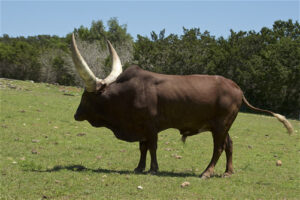 Saharan Africa but mainly in the East African countries of Uganda, Burundi and Rwanda. They are also found in Ghana and some other countries of west/Central Africa. Sanga Cattle are reared mainly within the cattle corridors that stretch between Uganda and Rwanda. These cattle corridors have the right climate and adequate pastures for extensive grazing. The Sanga cattle were first introduced in East Africa by ancient herdsmen who are believed to have originated from Egypt. The Ankole Cattle we are discussing in this article are a cross between the Zebu cattle from India and Sanga cattle.
Saharan Africa but mainly in the East African countries of Uganda, Burundi and Rwanda. They are also found in Ghana and some other countries of west/Central Africa. Sanga Cattle are reared mainly within the cattle corridors that stretch between Uganda and Rwanda. These cattle corridors have the right climate and adequate pastures for extensive grazing. The Sanga cattle were first introduced in East Africa by ancient herdsmen who are believed to have originated from Egypt. The Ankole Cattle we are discussing in this article are a cross between the Zebu cattle from India and Sanga cattle.
The Ankole cattle are believed to have been introduced in Uganda about 500 to 700 years ago by nomadic pastoralists who migrated to the country from other parts of the continent. The Ankole cattle are hardened breeds that can adopt to any weather conditions. They can survive in harsh conditions and with less food or drinking water. That ability to survive in difficult conditions is because their advanced 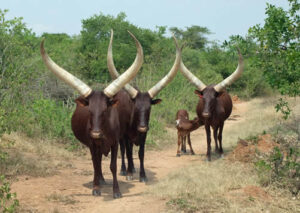 digestive system uses the available moisture in the body to slowly breakdown food. Because of their ability to survive in different environments, Ankole Cattle are easy to manage and do not need too much effort to keep them in condition. Farmers can expect good results with Ankole cattle if they can provide enough water and pasture. The size of Ankole cattle depend on how much pasture they feed on and how much care is given to them by their owners. It is important to give them a simple shelter which is spacious so that they do not hurt each other with their long horns and also to shield them from heavy rains.
digestive system uses the available moisture in the body to slowly breakdown food. Because of their ability to survive in different environments, Ankole Cattle are easy to manage and do not need too much effort to keep them in condition. Farmers can expect good results with Ankole cattle if they can provide enough water and pasture. The size of Ankole cattle depend on how much pasture they feed on and how much care is given to them by their owners. It is important to give them a simple shelter which is spacious so that they do not hurt each other with their long horns and also to shield them from heavy rains.
Variety of Longhorn Ankole Cattle
The Ankole cattle are divided into 4 sub-groups which include the Tutsi, Bahema, Kigezi and Bashi varieties. The Tutsi Variety were named after the Batutsi ethnic group of Rwanda and have the longest 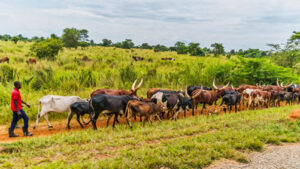 horns among the known breeds. The Tutsi breed are mainly dark brown in color and are predominantly seen in Burundi, just near Lake Tanganyika. The Bahema Variety have slightly shorter horns in comparison to the Tutsi breed. They are largely found in the northern parts of Kivu near lake Edward. The Bahema cattle are the most common breed in Uganda. The Kigezi Variety can be found at the foothills of the Kigezi hills. The Kigezi Variety are not so common but they have a close resemblance to the Bahema cattle. Last but not list is the Bashi variety. These cattle are found in the southern parts of lake Kivu.
horns among the known breeds. The Tutsi breed are mainly dark brown in color and are predominantly seen in Burundi, just near Lake Tanganyika. The Bahema Variety have slightly shorter horns in comparison to the Tutsi breed. They are largely found in the northern parts of Kivu near lake Edward. The Bahema cattle are the most common breed in Uganda. The Kigezi Variety can be found at the foothills of the Kigezi hills. The Kigezi Variety are not so common but they have a close resemblance to the Bahema cattle. Last but not list is the Bashi variety. These cattle are found in the southern parts of lake Kivu.
Where to see Longhorn Ankole Cattle
The Ankole cattle of Uganda are reared predominantly in Uganda’s western districts of Ntungamo, Bushyenyi, Insingiro, Kiruhura and Mbarara. When one visits these districts, they cannot fail to see 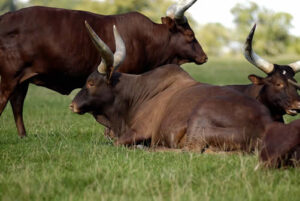 countless pastoralists holding sticks while moving long distances with large numbers of cattle grazing in the open fields and grasslands. The herdsmen keep close to their animals while they go about grazing to protect them from any form of danger. Danger can come from wild animals or cattle thieves. Ankole Cattle go out to graze in the mornings, drink in the afternoon and are taken back home later in the evenings. Because of declining space for grazing, some herdsmen have migrated to other parts of the country and beyond. You can read more about the Igongo Cultural Centre.
countless pastoralists holding sticks while moving long distances with large numbers of cattle grazing in the open fields and grasslands. The herdsmen keep close to their animals while they go about grazing to protect them from any form of danger. Danger can come from wild animals or cattle thieves. Ankole Cattle go out to graze in the mornings, drink in the afternoon and are taken back home later in the evenings. Because of declining space for grazing, some herdsmen have migrated to other parts of the country and beyond. You can read more about the Igongo Cultural Centre.
Price of Ankole Cattle
The Ankole cattle are one of the most valued breeds in the Ugandan market. They are sold at slightly higher prices in the market when compared to the other local cattle breeds. This is because of their huge 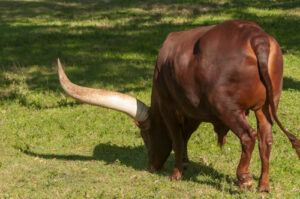 body sizes which provide a lot of meat hence fetching higher profits for abattoirs. The price of Ankole cattle are determined by physical sizes and age of the animals. What is the price of Ankole cattle? On average, the cost of mature adult Ankole Cattle goes for about 1000 US dollars which is 3.7 million Uganda Shillings. Ankole cattle are in most cases sold from within the cattle farm or by means of advertising. The most common way buyers get to know about a cow on market is through word of mouth from the sellers themselves or middlemen.
body sizes which provide a lot of meat hence fetching higher profits for abattoirs. The price of Ankole cattle are determined by physical sizes and age of the animals. What is the price of Ankole cattle? On average, the cost of mature adult Ankole Cattle goes for about 1000 US dollars which is 3.7 million Uganda Shillings. Ankole cattle are in most cases sold from within the cattle farm or by means of advertising. The most common way buyers get to know about a cow on market is through word of mouth from the sellers themselves or middlemen.
Importance of the Ankole Cattle
The Ankole cattle are a major source of livelihood for the people who rear them. Farmers can sell the animals to pay children’s school fees, medical bills and or finance other needs. Farmers can also sell the various animal products like meat, milk, ghee, skin and hooves among others.
Let us continue discussing the importance of the Ankole cattle: –
Great Milk Producers: The Ankole cattle are very important to the communities that rear them in many ways. The Ankole cow produces very nutritious milk. In fact, most of the milk produced in Uganda comes from Ankole Cattle. The milk has a high fat content from which ghee and yoghurt are extracted.
Source of Meat: Apart from milk, Ankole cattle are also good meat and blood producers. Blood from the cattle is cooked until it turns into dark brown. The pieces look like small pieces of fried liver and is a delicacy much enjoyed by the locals.
A measure of wealth: The Ankole cattle are used to measure wealth and social status in communities that keep them. People who own larger herds of cattle are more respected by the society compared to those with none or just a few. The cattle also help to forge friendships especially among herdsmen. As they go out to graze their cattle in the wild, they get an opportunity to meet others herdsmen who become lifelong friends. Meeting other herdsmen allows one learn the best way to rear their cattle.
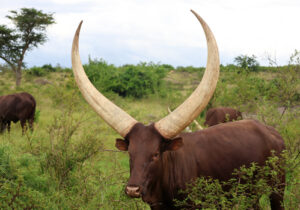 Dowry and Token of friendship: The Ankole cattle is very important during marriage ceremonies. The groom is expected to pay dowry for his bride in form of cattle whose numbers are determined by the bride’s family. A family with many girls can suddenly become wealthy if the girls get married around the same time. Apart from being used as dowry, Ankole cattle are also used as gifts by the local people. The local people consider cattle as the most precious gift to give to a friend or loved one. Even people who are already wealthy people will be impressed if you offer a good looking Ankole bull as a gift.
Dowry and Token of friendship: The Ankole cattle is very important during marriage ceremonies. The groom is expected to pay dowry for his bride in form of cattle whose numbers are determined by the bride’s family. A family with many girls can suddenly become wealthy if the girls get married around the same time. Apart from being used as dowry, Ankole cattle are also used as gifts by the local people. The local people consider cattle as the most precious gift to give to a friend or loved one. Even people who are already wealthy people will be impressed if you offer a good looking Ankole bull as a gift.
Valuable Horns: The long curved horns of the Ankole cattle are on high demand in the art and crafts industry. Artists design them in various shapes and styles as per client requests to act as decorations. The Ankole cattle horns are fairly huge and weigh between 900 to 1600 pounds. In order to ensure that they are not damaged in any way after extracting them from dead cattle, horns are wrapped in hides before being transported to market centers.
Valuable Cattle Skins and manure from cow dung: The cattle skins are very important for making clothes, foot wear, decorations, music instruments like drums and cultural regalia among others. The cattle wastes (urine and dung) are very important too. The urine is used for medicinal purposes while the cow dung is used for making final touches on buildings or to make the floor smooth. Cow dung and urine is excellent as manure in gardens.
In conclusion, the Ankole cattle are one of the best breeds in Africa. Those planning to start up farming enterprises should consider this unique breed of cattle because they are easy to manage and yet produce high returns.

